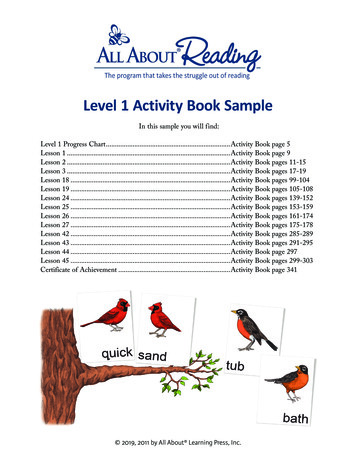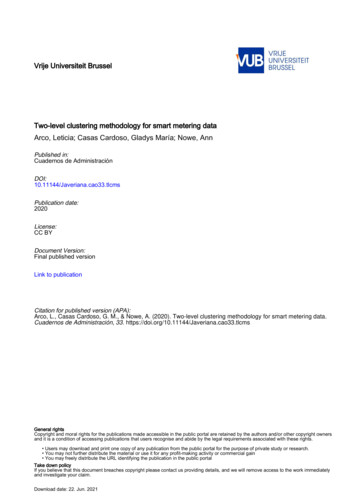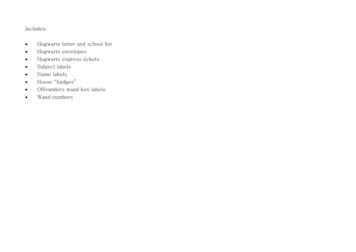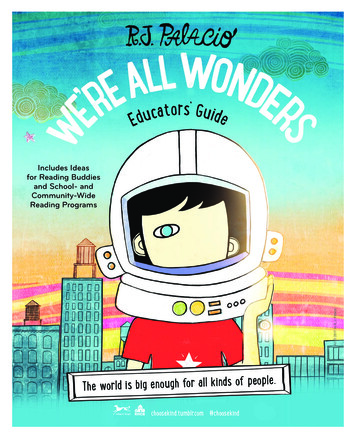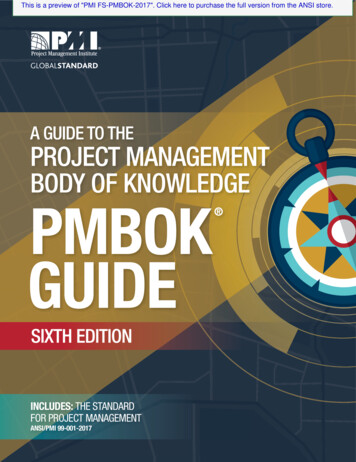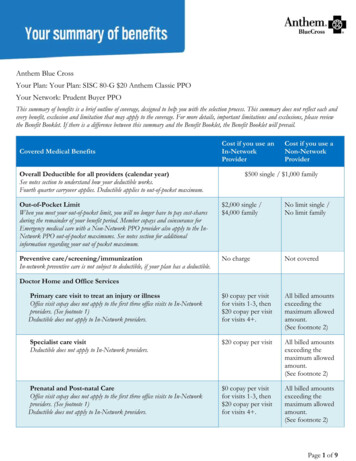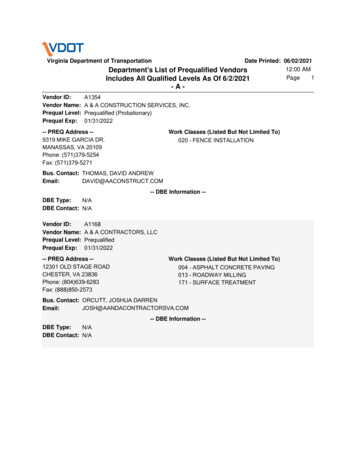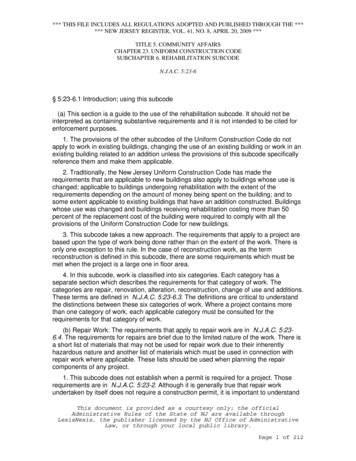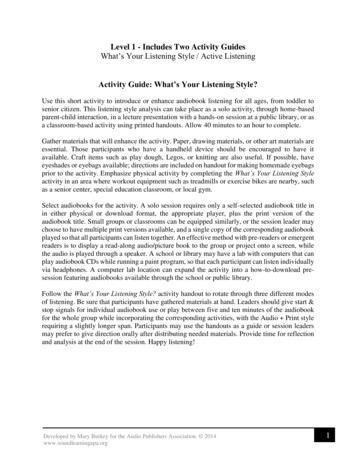
Transcription
Level 1 - Includes Two Activity GuidesWhat’s Your Listening Style / Active ListeningActivity Guide: What’s Your Listening Style?Use this short activity to introduce or enhance audiobook listening for all ages, from toddler tosenior citizen. This listening style analysis can take place as a solo activity, through home-basedparent-child interaction, in a lecture presentation with a hands-on session at a public library, or asa classroom-based activity using printed handouts. Allow 40 minutes to an hour to complete.Gather materials that will enhance the activity. Paper, drawing materials, or other art materials areessential. Those participants who have a handheld device should be encouraged to have itavailable. Craft items such as play dough, Legos, or knitting are also useful. If possible, haveeyeshades or eyebags available; directions are included on handout for making homemade eyebagsprior to the activity. Emphasize physical activity by completing the What’s Your Listening Styleactivity in an area where workout equipment such as treadmills or exercise bikes are nearby, suchas a senior center, special education classroom, or local gym.Select audiobooks for the activity. A solo session requires only a self-selected audiobook title inin either physical or download format, the appropriate player, plus the print version of theaudiobook title. Small groups or classrooms can be equipped similarly, or the session leader maychoose to have multiple print versions available, and a single copy of the corresponding audiobookplayed so that all participants can listen together. An effective method with pre-readers or emergentreaders is to display a read-along audio/picture book to the group or project onto a screen, whilethe audio is played through a speaker. A school or library may have a lab with computers that canplay audiobook CDs while running a paint program, so that each participant can listen individuallyvia headphones. A computer lab location can expand the activity into a how-to-download presession featuring audiobooks available through the school or public library.Follow the What’s Your Listening Style? activity handout to rotate through three different modesof listening. Be sure that participants have gathered materials at hand. Leaders should give start &stop signals for individual audiobook use or play between five and ten minutes of the audiobookfor the whole group while incorporating the corresponding activities, with the Audio Print stylerequiring a slightly longer span. Participants may use the handouts as a guide or session leadersmay prefer to give direction orally after distributing needed materials. Provide time for reflectionand analysis at the end of the session. Happy listening!Developed by Mary Burkey for the Audio Publishers Association. 2014www.soundlearningapa.org1
What’s Your Listening Style?What’s Your Listening Style?Name:Are you new to audiobooks? Try these different ways to explore the audio genre. Or have youlistened once and hated it? You may not have discovered the way that fits you best. Are you aregular audio listener? Expand your listening opportunities. There’s no best way, and everyonehas their own listening style. Experiment with the suggestions below, and find your favorite! Busy body, attentive brain listening style: I like to move while listening. If I try to sit stilland listen to an audiobook, I lose track of the story. When I keep my hands busy or bodymoving, the words flow into my brain.Activities for this listening style: Artistic movement like doodling, drawing what you hear, oran online paint application. Handheld devices with simple video games such as Bejeweled,Temple Run, Minecraft or Solitaire. Crafts like Legos, play dough, knitting. Activities like dailychores, cleaning, cooking, yard work. Movement like walking to school, sports practice, ridingthe bus, exercise, car trips, walking the dog.Now you try it: As you listen to a short audiobook segment, draw what you hear,doodle, sketch characters, or jot down memorable words. Play a game with the soundmuted while you listen to the audiobook. Or chose another busy body, listening brainactivity!Developed by Mary Burkey for the Audio Publishers Association. 2014www.soundlearningapa.org2
What’s Your Listening Style? Relax while reading with my ears listening style: I like to block out the world and listen,and let the words paint a picture in my mind.Activities for this listening style: Chill out in your bedroom, listening with the lights out. Putearbuds in and close your eyes when on the bus or in the car. Listen in the classroom during freechoice reading time, headphones on and head down on desk. Try a homemade eyebag: Take anold kneesock or cut a leg off an old pair or tights, fill with dry beans or rice, and tie securely. Liedown with the eyebag over your eyes to help you relax and listen.Now you try it: As you listen to a short audiobook segment, turn out the lights, closeyour eyes, and let a short audiobook segment create a movie in your mind! Audio print listening style: I like to have both the print text and audiobook, and Icombine the two for greater understanding and enjoyment.Activities for this listening style: Some people like to follow along in the print book whilelistening, with the combination making the text easier to understand. Other people hate to try tofollow along with the book, as their reading speed and listening speed don’t match. But manypeople like to listen to a chapter, and then read the same chapter in the print book, with the twoversions combining to make the text more interesting. Some very fast print readers like to read awhole book, then go back and listen to the audiobook, and discover many details they missed thefirst time. If you are a voracious reader, go back and listen to an old favorite!Now you try it: As you listen to a short audiobook segment, follow along with theprinted book for a few pages. Next, just listen for a few minutes, then pause the audioand go back and read the same segment in the print book. Or get creative and combinethe Busy Body or Relaxation listening style, and then pause the audio and re-read thesame segment in print.Developed by Mary Burkey for the Audio Publishers Association. 2014www.soundlearningapa.org3
What’s Your Listening Style? Analyze your style: What’s your favorite way to listen? Does one style help youcomprehend the book better? Do you have more than one style? Does the listeningexperience transform your understanding? Support your choice with observations below:Developed by Mary Burkey for the Audio Publishers Association. 2014www.soundlearningapa.org4
Activity Guide: Active ListeningUse this method to enhance the use of audiobooks in an instructional setting, incorporating theeducational benefits of audio in a technology-rich, multi-sensory environment. Use the simpleActive Listening lesson to foster student engagement and introduce analysis of audio-specificcharacteristics, an ideal follow-up to the What’s Your Listening Style activity. Before independentuse of the Active Listening handout, model as a single period, whole-class activity with a shortread-along audio/picture book displayed or projected by a document camera, with the audio playedthrough speakers. Take time to pause and define audio qualities such as Pace, Emotion, andRhythm—the Audiobook Lexicon serves as a helpful tool. This whole-class method is also an idealway to integrate literature while introducing a new curricular focus using an audio/picture bookfor older students tied to core content, such as the Live Oak Media production of When MarianSang prior to a Civil Rights Social Studies unit.Once students have been introduced to audiobook evaluation, move on to the resources in Level 2to match instructional needs.Developed by Mary Burkey for the Audio Publishers Association. 2014www.soundlearningapa.org5
Active ListeningActive ListeningName DateAudiobook Title:Before you start, tell why you picked this book and what you think it will be about.Memory Map: As you listen, draw or write words to help you remember what you hear. Useanother sheet of paper if needed.Developed by Mary Burkey for the Audio Publishers Association. 2014www.soundlearningapa.org6
Active ListeningPrediction and Inference: Half-way, pause & guess what will happen next. What clues in thetext led you to make this prediction?When you are done listening to the audio, answer these questions.Character Clues:What do you learn about the character from listening? Think about: Did the narrator have emotion in his/her voice? Cite an example and explain howthat helped you understand the character. Did the narrator emphasize any words? What were they, and how did this help youlearn more about the character? How did the narrator read the dialogue? How did the way the characters spoke toeach other help you understand them more?Developed by Mary Burkey for the Audio Publishers Association. 2014www.soundlearningapa.org7
Active ListeningSee the Setting through Sound: Can you hear where the action is taking place? Doesmusic set the scene? Are there sound effects that expand the text or illustrations?Does the narrator’s voice fit the time period? Are words from a region or country spoken clearly?Reading with your Ears: How does hearing the text help you remember details,visualize action, or create meaning? Cite an example of a place during the audio wherehearing the story helped you.Developed by Mary Burkey for the Audio Publishers Association. 2014www.soundlearningapa.org8
Now you try it: As you listen to a short audiobook segment, turn out the lights, close your eyes, and let a short audiobook segment create a movie in your mind! Audio print listening style: I like to have both the print text and audiobook, and I

